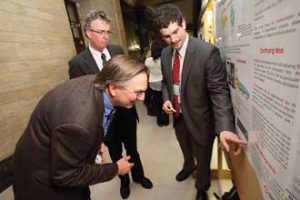
By Tamarah Feder
What does one need to get on the path to becoming a Nobel laureate? Gifted curiosity, some inspirational professors and, oh, a mom who brought chemicals home from work for her son to play with.
For Jack Szostak who, along with Elizabeth Blackburn and Carol Greider, won the 2009 Nobel Prize in Physiology or Medicine, getting to that point and beyond was never a straight line, as he told undergraduate science students last week. The lecture, preceded by a ceremony awarding prizes to students for their research projects, was part of the Sixth Annual Faculty of Science Undegraduate Research Conference.
Szostak’s interest in science began at his Pierrefonds home and was fed by his mother, who worked for a chemical company. She brought “samples” home for him to play with, some of which he said, with a mischievous smile, “might be considered illegal today.” His father built him a small lab where he conducted his initial experiments. A picture of a very fiery explosion appeared on the screen to illustrate his success.
Szostak graduated from McGill with a BSc at the tender age of 19 and completed his PhD at Cornell by the time he was 24. Describing the twists and turns he took in his academic career following some frustrating experiments and even a bit of boredom, Szostak said he decided to explore other areas. That journey culminated in ground-breaking research that broadened the understanding of the working of telomerase. That’s the enzyme that helps protect the tips of chromosomes called telomeres. His research has helped advance the study of cells and how they age and die. He also created the first yeast artificial chromosome, an achievement that helps scientists map genes in mammals and find ways to manipulate genes.
Szostak told the group of McGill’s top science students curious about what it takes to go from student to Nobel laureate to “find interesting projects, a big question that’s doable, and then make sure it’s not something that everyone else is doing.” He also urged students to research everything about everything, explaining that it was his persistent interest in sciences beyond his initial track – and some serendipitous meetings – that ultimately led him to making important discoveries in genetics and brought satisfaction as well as groundbreaking success.
Asked what he thought has changed at McGill since his student days, Szostak noted that “gatherings such as this make it much easier now than when I was a student. They help connect students with professors and learn about mutual interests. In my day, professors seemed very scary and it took a lot of guts to go knock on their doors.”
Today, Szostak is Professor of Genetics at Harvard Medical School and Alexander Rich Distinguished Investigator at Massachusetts General Hospital in Boston. In keeping with the wiggly path he started on, he has now turned his attention backward – about 4 billion years, give or take – as he seeks the origin of life and the emergence of Darwinian evolution by recreating the chemical origins of life in a test tube.
Makes you wonder what his trajectory might have been had his mom had a different job.
To view Dr. Szostak’s speech online, please visit http://bcooltv.mcgill.ca/
